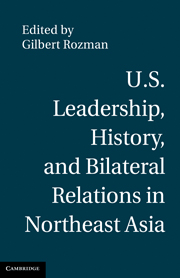Book contents
- Frontmatter
- Contents
- List of Contributors
- Acknowledgments
- U.S. Leadership, History, and Bilateral Relations in Northeast Asia
- Introduction
- PART I HISTORICAL MEMORIES AND BILATERAL TIES WITH ALLIES
- PART II HISTORICAL MEMORIES, JAPANESE–SOUTH KOREAN RELATIONS, AND U.S. VALUES
- PART III HISTORICAL MEMORIES, SINO–SOUTH KOREAN RELATIONS, AND U.S. VALUES
- 7 Sino–South Korean Differences over Koguryo and the U.S. Role
- 8 New Grounds for Contestation
- 9 U.S. Strategic Thinking on Sino–South Korean Differences over History
- Index
8 - New Grounds for Contestation
South Korea's Koguryo-Era Historical Dramas and Sino-Korean Relations
from PART III - HISTORICAL MEMORIES, SINO–SOUTH KOREAN RELATIONS, AND U.S. VALUES
Published online by Cambridge University Press: 01 March 2011
- Frontmatter
- Contents
- List of Contributors
- Acknowledgments
- U.S. Leadership, History, and Bilateral Relations in Northeast Asia
- Introduction
- PART I HISTORICAL MEMORIES AND BILATERAL TIES WITH ALLIES
- PART II HISTORICAL MEMORIES, JAPANESE–SOUTH KOREAN RELATIONS, AND U.S. VALUES
- PART III HISTORICAL MEMORIES, SINO–SOUTH KOREAN RELATIONS, AND U.S. VALUES
- 7 Sino–South Korean Differences over Koguryo and the U.S. Role
- 8 New Grounds for Contestation
- 9 U.S. Strategic Thinking on Sino–South Korean Differences over History
- Index
Summary
The emergence of the controversy in 2003 and 2004 over whether the Koguryo kingdom (37 bc–668 ad) was properly a precursor to or influence on the development of the modern Chinese or Korean state has marked an important shift in Korean public perceptions of China that could have political ramifications for the future of the Sino-Korean relationship. Competing North Korean and Chinese applications to register Koguryo-era tombs as a UNESCO “world heritage” site gained media attention in South Korea and raised South Korean public concerns about Chinese efforts launched in 2003 to pursue historical and archaeological research on Koguryo history as part of its multiyear, state-sponsored Northeast Project. This campaign was part of China's effort to strengthen the historical basis for claiming that ethnic minority areas within China would be historically identified with China through “internalization of border areas” (bianjiang neidihua).
Chinese Foreign Ministry efforts to revise the Korean history section of its own website in the summer of 2004 stirred up a firestorm of controversy in South Korea (but virtually no media coverage or public awareness in China), necessitating the negotiation of a five-point oral agreement between China and South Korea in December of that year over how to manage the conflict. It also stimulated public demands for South Korean government–led efforts to promote archaeological and historical research on Koguryo to match the Chinese Northeast Project that would be used to validate claims that Koguryo was indeed “Korean” and not “Chinese.”
- Type
- Chapter
- Information
- Publisher: Cambridge University PressPrint publication year: 2010

